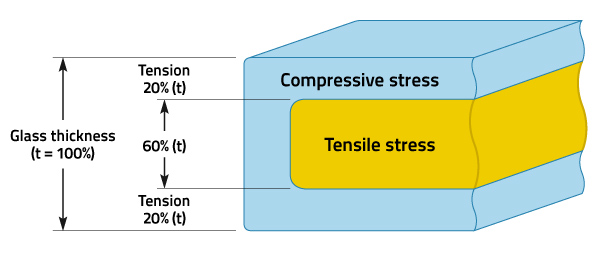Tempered safety glass panel – a glass panel subjected to heat or chemical treatment in order to create stresses that cause a mechanical strength increase and a crack as a result of a stroke or overload in a safe way.
Properties of tempered glass
Tempered glass is characterized by increased mechanical and thermal strength and a special way of breaking into small chips which do not hurt a person, thus it is considered to be safe.
The increased mechanical and thermal strength of tempered glass is explained as a result of a specific thermal stress pattern in the glass panel in which at symmetrical, homogenous cooling such a stress pattern is achieved, where external layers constitute a compressive stresses zone, and internal ones are a tensile stresses zone.
The compressive stresses in superficial layers of glass make it possible to impose a bending load which is considerably higher than in case of normally annealed glass due to compensation of the tensile stresses and thus reducing a local resultant stress. An average breaking stress for tempered glass exceeds several times the strength of ordinary glass. The phenomenon of static fatigue of glass is also reduced. By means of superposition of stresses we achieve a reduction of a dangerous highest breaking stress which limits the glass strength.

Drawing 1. Stress pattern existing in a tempered glass panel
In the tempered state, surface defects cannot spread through the external zone, which is under compressive stress.
Having exceeded the mechanical strength, tempered glass bursts into small blunt chips thanks to which it is included among safe glass. Heat tempered glass has a wide application in construction industry, furniture, household appliances (used in ovens thanks to high thermal resistance), automotive industry, rail, air and sea service, transport industry and many other branches of economy.









